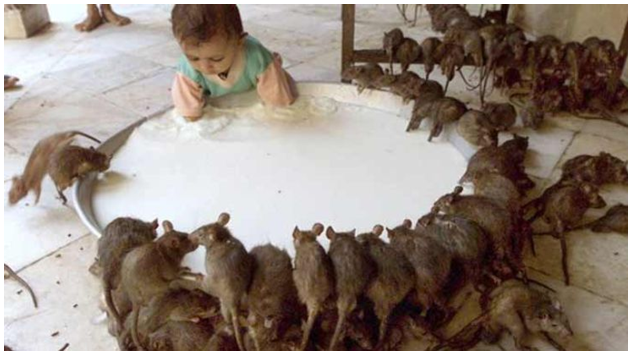Many Consider Rats Holy, So Why Is The Focus Only On the Cow?
HYDERABAD: Rats are various medium-sized, long-tailed rodents of the superfamily Muroidea. "True rats" are members of the genus Rattus, the most important of which to humans are the black rat, Rattus rattus, and the brown rat, Rattus norvegicus. Many members of other rodent genera and families are also referred to as rats, and share many characteristics with true rats.
Rats are typically distinguished from mice by their size. Generally, when someone discovers a largemuroid rodent, its common name includes the term rat, while if it is smaller, the name includes the termmouse. The muroid family is broad and complex, and the common terms rat and mouse are nottaxonomically specific. Scientifically, the terms are not confined to members of the Rattus and Musgenera, for example, the pack rat and cotton mouse. The best-known rat species are the black rat (Rattus rattus) and the brown rat (Rattus norvegicus).
The Common Rat (rattus rattus), venerated by many Hindus is known being attacked from many directions. The government authorities consider rats as vermin and want their eradication. According to Maneka Gandhi, the Rat began to appear as the principal vehicle in sculptures of Ganesha in central and western India during the 7th century; the rat was always placed close to his feet. The mouse as a mount first appears in written sources in the Matsya Purana and later in the Brahmananda Purana and Ganesha Purana, where Ganesha uses it as his vehicle only in his last incarnation. The Ganapati Atharvashirsa includes a meditation verse on Ganesha that describes the mouse on his flag.
According to Maneka Gandhi, rats are also symbols of fertility. They breed like crazy. Ganesha is always associated with fertility symbols. The Dhurva grass for example, which keeps growing even when uprooted. If Dhurva is the plant-symbol of fertility, rat is the animal-symbol of fertility.. Rats are also unstoppable, relentless, breaking through any obstacle to get to the grain.
Simultaneously, rats are symbols of avarice and greed. They are relentless hoarders. Thus, rats have a positive aspect (fertility/unstoppability) and a negative aspect (pilferage/plague). With Ganesha sitting on top of Mooshika only the positive aspects reach devotees while the negative aspects stay away. But Maneka's sister Ambika has a simpler explanation for Ganesha's preference for the rat. She say: "The mouse is the smallest and most vulnerable of all. That is why Ganesha himself protects him." But apparently not so in a BJP/RSS dispensation?
The Karni Mata Temple is a famous Hindu temple dedicated to Karni Mata at Deshnoke, 30km from Bikaner, in Rajasthan, India. It is also known as the Temple of Rats. The temple is famous for the approximately 20,000 black rats that live, and are revered in, the temple. These holy rats are called kabbas, and many people travel great distances to pay their respects. The temple draws visitors from across the country for blessings, as well as curious tourists from around the world.
Even before Jitan Ram Manjhi, the rat has been identified by government officials as a source of protein in preference to the common Indian bovine. Apparently rats are easily available and in plenty, just as cows are. Then why this focus on rats as an edible item?
Indians living in Bihar, the country's poorest state have been told to eat rats. The rodents are already consumed by an impoverished caste in Bihar called the Musahars or 'rat-eaters' - but most people find the idea distasteful. Now state officials are asking hotels and restaurants to devise interesting ways of poaching, roasting or stewing the meat.
'Once people accept it as just another meat like chicken or mutton, it will become popular,' said Vijay Prakash, Bihar's one time social welfare secretary. Rat meat is already cooked in some Bihar villages and Mr Prakash's mission is to spread the taste to urban areas because poor rat-catchers will only make enough money once demand grows.
'It is very high in protein and the beauty is that we have billions of rats,' he said. He wants rat snacks served at bus and train stations, and roadside cafes. 'In the countryside, in roadside cafes, people have rats as a snack with drinks,' he added. Mr Prakash's objective is to give Bihar's poor a source of nourishment and income.
'India has about eight rats per person. If rat meat sells for 50 rupees a kilo and each rat weighs a kilo - field rats are fat and heavy - then a poor family can make 150 rupees a day by catching just three rats. 'Once it becomes as normal as chicken, then I will encourage people to start rat farming.'
The Musahars are a Hindu scheduled caste found in the states of Bihar and Uttar Pradesh in India, and Terai. They are also known as Arya or Banbasi and on the plateau as Manjhi.
The Musahar were traditionally rat catchers, and there is still uncertainty as to their exact origin. This Hindu Mythology story shows how they are perceived in the traditional Indian society, Parmashwar (the Hindu creation god) created man and gave him a horse to ride. The first Musahar decided to dig holes in the belly of the horse to fix his feet as he rode. This offended Parmeshwar, who punished them by making them rat catchers. They are found in eastern Uttar Pradesh, Bihar and north Madhya Pradesh. The Musahar speak the Bhojpuri dialect ofHindi. In Bihar, the word Musahar is said to be derived from moos, a local Bhojpuri and Sanskrit [Moosak] word for a rat, on account of their traditional occupation as rat catchers.
The rat has other uses too. According to a audit report in Bihar, the State Transport Corporation attributed the disappearance of several thousand bus tyres with a simple explanation: “Moos kha gaya!” Don’t believe me, ask Yashwant Sinha.
(Cover Photograph: Kami Mata Temple, Rajasthan)





